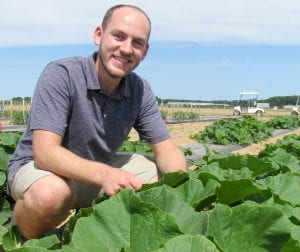
Vegetable Pathology Research and Extension Program objectives:
Optimize management of diseases affecting vegetables grown on Long Island within organic as well as conventional production systems by:
- Investigating pathogen biology, including sources.
- Developing scouting protocols and action thresholds.
- Evaluating control practices, including fungicides, resistant varieties, integration of chemical and genetic control, and biofumigation.
Examine impact on diseases of practices to improve soil health: annual compost amendments, reduced tillage, and clover living mulch.
Diagnose disease problems for growers.
Determine impact of ambient ozone on plant productivity.
Seminar by Meg McGrath [25 October 2022]:
How cucurbit powdery mildew filled an interesting, rewarding career.
Pumpkin growers were concerned about lost control of powdery mildew in 1988 when I started at Cornell’s Long Island research facility. Procedures were developed that enabled documenting the pathogen had become resistant to the main fungicide in use, a DMI (FRAC group 3). Fungicides with single site mode of action remain essential for effective control because they move to the abaxial leaf surface where powdery mildew develops best. Resistance has been detected to 4 of 6 chemistries registered since 1988 (FRAC 7, 11, 13, U06), all US firsts. Increasing occurrence of isolates with multi-fungicide resistance is a major issue. To provide conventional and organic growers with other information needed to effectively manage this common disease, research also includes evaluating resistant varieties, new and older fungicides at risk for resistance developing, and biopesticides. Additionally, the pathogen’s taxonomic name was corrected to Podosphaera xanthii, heterothallic status determined, mating type distribution examined, and epidemiological role of ascospores studied. While every year there have been questions to address about managing cucurbit powdery mildew, there was time to also work on new and re-emerging diseases: Phytophthora blight, basil downy mildew, cucurbit downy mildew, and late blight.

Questions? Contact:
Margaret McGrath
Associate Professor
Plant Pathology and Plant-Microbe Biology Section
School of Integrative Plant Science
Cornell University
Long Island Horticultural Research & Extension Center
Riverhead, NY 11901-1098
(631) 727-3595
Email: mtm3@cornell.edu



